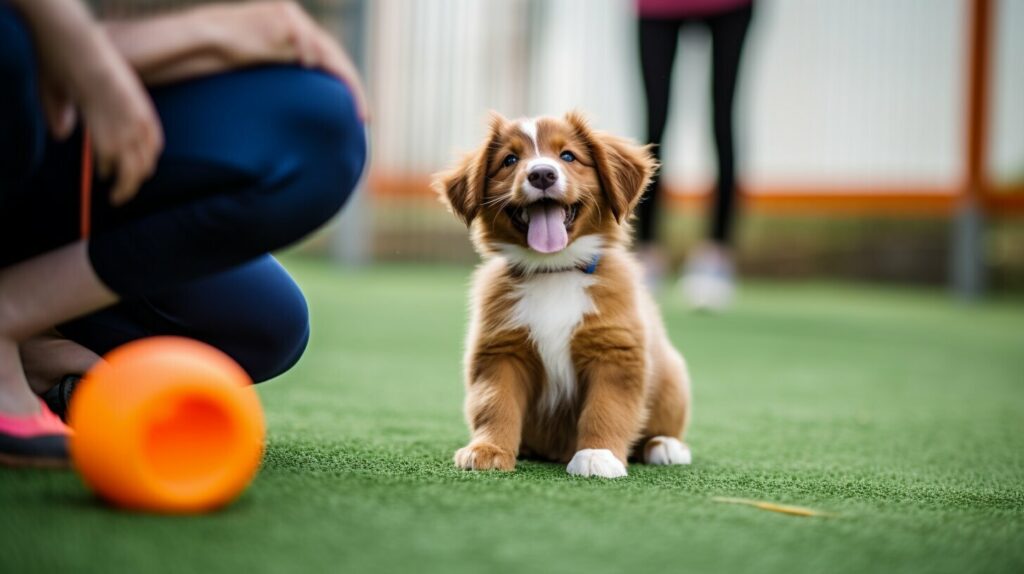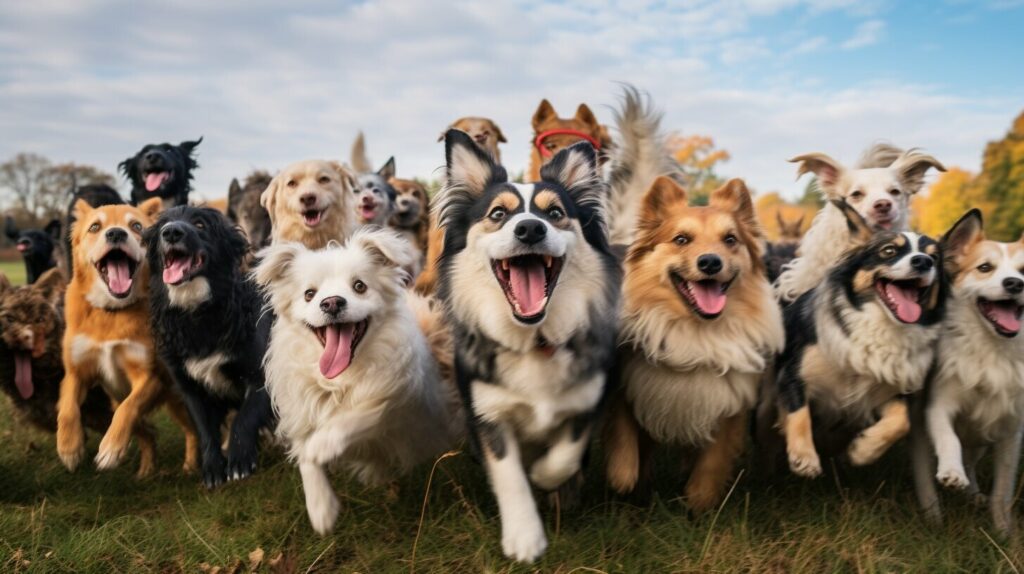If you’re a dog owner, you know that training your pup can sometimes be frustrating. Whether you’re trying to teach them obedience or new tricks, it can be a challenge to get your dog to understand what you want them to do. That’s where using a clicker for training dogs can come in handy.
A clicker is a small device that makes a clicking sound when pressed. It’s used in clicker training for dogs as a way to communicate with your pup and reinforce positive behaviors. With clicker training, you can teach your dog new skills and behaviors, all while strengthening your bond with them.
Key Takeaways:
- Clicker training is a method of training dogs using positive reinforcement.
- A clicker is a small device that makes a clicking sound when pressed.
- Clicker training can help enhance communication, speed up learning, and strengthen the bond between you and your dog.
The Basics of Clicker Training for Dogs
Clicker training is a form of positive reinforcement training that uses a handheld clicker to signal to the dog that they have done something right. The technique relies on the principle that dogs will repeat behaviors that lead to positive outcomes. Here’s how it works:
- Choose your reward. Before you start training, decide on a high-value treat that your dog loves. This could be pieces of chicken, cheese, or dog treats.
- Click and treat. When your dog does something you want them to do, such as sitting or coming when called, click the clicker and immediately give them a treat. This helps to create a positive association between the sound of the clicker and the reward.
- Avoid punishing your dog. Clicker training is based on positive reinforcement, which means that you should reward your dog for good behavior rather than punishing them for bad behavior.
Clicker training can be used to teach your dog a variety of behaviors, from basic obedience commands like “sit” and “stay” to more complex tricks like spinning or jumping through a hoop. Here are some clicker training techniques you can use:
- Shaping: This technique involves breaking down a behavior into small steps and rewarding your dog for each step they take towards the final behavior.
- Luring: This technique involves using a treat to guide your dog into the desired behavior, such as holding a treat above their head to get them to sit.
- Capturing: This technique involves waiting for your dog to naturally perform a behavior you want to reinforce, such as lying down, and then clicking and treating.
Positive reinforcement training is an effective and humane way to train your dog, and clicker training can make the process even more efficient and enjoyable for both you and your furry friend.
Getting Started with Clicker Training
Before starting clicker training, it’s essential to establish the fundamentals of dog obedience training. Here are a few clicker training tips:
- Consistency is key: Create a consistent training routine to ensure your dog understands what is expected of them.
- Timing is crucial: The click should immediately follow the desired behavior, and the treat should be given promptly after the click.
- Set clear expectations: Make sure your dog understands what they’re doing right by consistently clicking and treating them when they exhibit the desired behavior.
In addition to these tips, you should also create a positive training environment. Find a quiet, distraction-free area for training sessions. Use treats that your dog loves and enjoy the training process.
The Benefits of Clicker Training
Clicker training has numerous benefits for you and your dog.
- Effective communication: Clicker training helps to establish clear communication between you and your dog. The consistent sound of the clicker communicates to your dog exactly what behavior is being rewarded.
- Increases learning speed: Clicker training can accelerate learning by helping your dog understand which behaviors are desirable and should be repeated. It also helps your dog understand the consequences of their actions quickly.
- Positive reinforcement: Clicker training relies on positive reinforcement, which is a gentle and effective way to train your dog. It encourages your dog to work for rewards and helps to build a strong bond between you and your pet.
- Enhances focus and attention: Clicker training can improve your dog’s focus and attention to commands. It teaches your dog to pay attention to you and stay focused on the task at hand, making training sessions more productive.
- Increases motivation: Clicker training helps to keep your dog motivated and engaged in the training process by offering consistent rewards for good behavior.
- Encourages creativity: Clicker training allows for a more creative approach to training, as it enables you to shape and capture behaviors that are not typically taught through traditional training methods.
Overall, using a clicker for training dogs is an effective and enjoyable way to train your furry friend. It offers numerous benefits while strengthening the bond between you and your pet.
Advanced Techniques in Clicker Training
Once you’ve mastered the basics of clicker training, it’s time to move onto more advanced techniques. These methods can help you shape specific behaviors and take your dog’s training to the next level. Here are some clicker training techniques to practice:
Shaping Behaviors
Shaping behaviors is a technique where you reward your dog for making gradual progress towards a specific behavior. This involves breaking down the behavior into smaller steps and rewarding each step along the way. For example, if you’re trying to teach your dog to roll over, you may reward them for lying down first, then for shifting onto their side, and then for completing the full roll over. This method can be time-consuming, but it helps dogs learn at their own pace and builds their confidence.
Targeting
Targeting involves getting your dog to touch a specific object with their nose or paw. This is a useful technique for teaching dogs to follow a specific path or for agility training. To start, hold out your hand with a treat in it and wait for your dog to touch it with their nose. Once they’re comfortable with this, switch to a different object like a target stick or a cone. Use the clicker to mark the moment they touch the object and reward them with a treat.
Capturing Desired Actions
Capturing desired actions involves waiting for your dog to perform a behavior on their own and then rewarding them for it. This is useful for behaviors that are difficult to shape, such as sneezing or yawning. Keep your clicker and treats handy throughout the day and wait for your dog to perform the behavior. As soon as they do, use the clicker and reward them with a treat. Over time, they’ll learn that these behaviors are desirable and will start doing them more often.
These advanced clicker training techniques require patience and practice but can help you achieve more specific training goals with your dog. Remember to keep training sessions short and positive, and always end on a high note. By using clicker training techniques, you can build a stronger bond with your dog and improve their behavior.
Troubleshooting Common Challenges in Clicker Training
Clicker training is a highly effective way to train your dog, but it’s important to remember that it’s not a magic solution. There are bound to be challenges along the way, but with some patience and persistence, you can overcome them. Here are some common issues that dog owners face during clicker training and how to troubleshoot them.
Distractions
One of the biggest challenges in clicker training is dealing with distractions. Your dog may be easily sidetracked by new sounds, smells, or sights. To overcome this challenge, start training in an environment with fewer distractions and gradually increase the level of distractions. This will help your dog build up their focus and attention.
Fear
Another common issue that dog owners face during clicker training is fear. If your dog is afraid of the clicker sound, you can try using a quieter clicker or wrapping the clicker in a towel to muffle the sound. Gradually increase the volume of the clicker as your dog becomes more comfortable with it.
Stubborn Behavior
Sometimes, despite your best efforts, your dog may refuse to follow your commands. This can be frustrating, but it’s important to remain patient and persistent. Try breaking down the command into smaller steps and rewarding your dog for completing each step. This will help build up their confidence and motivation.
Clicker Training Tips
- Be consistent in your training sessions. Set aside regular times each day to work on training.
- Use high-value treats that your dog loves to motivate them during training.
- Keep training sessions short and sweet. Aim for 5-10 minutes at a time.
- Use a clear and consistent command when teaching a new behavior.
- Timing is key in clicker training. Make sure you click at the exact moment your dog performs the desired behavior.
- Be patient and don’t get frustrated if progress is slow. Every dog learns at their own pace.
By following these tips and troubleshooting common challenges, you can ensure a successful clicker training experience with your dog. Keep in mind that every dog is different and may require different techniques, so don’t hesitate to seek professional help if needed.
Clicker Training Resources and Tools
While clicker training is a relatively simple concept, there are many resources and tools available that can enhance your training experience. Whether you’re a first-time dog owner or a seasoned trainer, these resources can help you achieve optimal results.
Books
There are many great books available about clicker training for dogs. Some popular options include “Don’t Shoot the Dog” by Karen Pryor, “The Power of Positive Dog Training” by Pat Miller, and “Clicking with Your Dog” by Peggy Tillman. These books offer a wealth of information and practical tips that can help you become a more effective clicker trainer.
Online Courses
There are also many online courses available that focus on clicker training for dogs. These courses often include video demonstrations, step-by-step instructions, and live support from experienced trainers. Some popular options include Udemy, Karen Pryor Academy, and Coursera.
Clicker Training Apps
If you prefer to use technology in your training, there are also several clicker training apps available. These apps allow you to track your progress, set reminders for training sessions, and access training resources on-the-go. Some popular options include Clicker Training and Clicker Training Buddy.
Training Tools
There are also a variety of training tools that can help you during clicker training sessions. Some popular options include target sticks, treat dispensers, and training mats. These tools can help you to reinforce positive behavior and create a more structured training environment.
By utilizing these resources and tools, you can maximize the effectiveness of clicker training with your dog. Whether you’re looking to overcome challenges, improve your skills, or simply enhance your training experience, these options can support you in achieving your training goals.
How to Train a Dog with a Clicker: Step-by-Step Guide
Clicker training can be a highly effective way to improve your dog’s behavior and obedience. Here is a simple step-by-step guide on how to train a dog with a clicker:
- Introduce the clicker: Start by introducing your dog to the clicker. Click the device several times in a row and immediately give your dog a treat. Repeat this several times until your dog associates the sound of the clicker with a positive outcome.
- Start with a simple command: Choose a simple command such as “sit” or “stay” and give the command. As soon as your dog responds correctly, click the device and give a treat. Repeat this several times until your dog associates the click with the desired behavior.
- Gradually increase difficulty: Once your dog has mastered a simple command, gradually increase the difficulty level. For example, you can start adding distractions or increasing the distance between you and your dog. Remember to always click and treat when your dog responds correctly.
- Shape behavior: Clicker training allows you to shape your dog’s behavior by rewarding small steps towards the desired behavior. For example, if you want your dog to roll over, you can start by rewarding your dog for lying down, then for turning its head, and so on until your dog completes the entire behavior.
- Use positive reinforcement: Remember to use positive reinforcement throughout the training process. Avoid punishing your dog for incorrect behavior and instead focus on rewarding the desired behavior.
- Consistency is key: Consistency is crucial when it comes to clicker training. Make sure to use the same command, clicker, and reward every time you train your dog. This will help your dog understand what is expected of it and speed up the learning process.
By following these simple steps, you can effectively train your dog using a clicker. Remember to be patient and consistent, and always end each training session on a positive note.
Conclusion
Now that you understand the benefits of using a clicker for training dogs, it’s time to put this knowledge into practice. Remember to start with the basics of positive reinforcement and consistency, and then progress to more advanced techniques such as shaping and targeting.
Don’t get discouraged if you encounter challenges during training sessions. With patience and persistence, you can overcome common obstacles such as distractions and stubborn behavior. Always create a positive environment during training and reward your furry friend for their progress.
Finally, take advantage of additional resources such as books, online courses, and clicker training apps. These tools can provide valuable insight and help you take your training to the next level.
Get Started Today!
By incorporating clicker training techniques into your dog’s obedience training, you can maximize efficiency and enhance your bond with your furry companion. Follow the step-by-step guide provided in this article and start seeing results today!
FAQ
Q: What is clicker training for dogs?
A: Clicker training for dogs is a positive reinforcement training technique that uses a clicker, a small handheld device that makes a distinct clicking sound, to mark desired behaviors. The clicker is paired with rewards, such as treats or praise, to reinforce the behavior and encourage the dog to repeat it.
Q: How does clicker training work?
A: Clicker training works by associating the sound of the clicker with a positive reinforcement, such as a treat. When the dog performs a desired behavior, such as sitting or lying down, the clicker is clicked and immediately followed by a reward. Over time, the dog learns to associate the click with the reward, and the clicker becomes a powerful tool for communication during training sessions.
Q: What are the benefits of clicker training?
A: Clicker training offers numerous benefits for both dogs and their owners. It provides clear communication between the trainer and the dog, enhances the learning process, and strengthens the bond between the two. Additionally, clicker training allows for precise timing, making it easier to capture and reinforce desired behaviors.
Q: Can any dog be trained using a clicker?
A: Yes, clicker training can be used with dogs of all ages, breeds, and sizes. It is a versatile training method that can be tailored to suit the individual needs and abilities of each dog. However, it is important to note that consistency, patience, and positive reinforcement are key factors in successful clicker training.
Q: How do I start clicker training with my dog?
A: To start clicker training with your dog, you will need a clicker, treats, and a quiet training area. Begin by clicking the clicker and immediately giving your dog a treat. Repeat this several times to establish the association between the click and the reward. Then, start clicking and rewarding your dog for desired behaviors, gradually shaping their behavior over time.
Q: What if my dog doesn’t respond to the clicker?
A: If your dog doesn’t respond to the clicker initially, it may be because they are not yet familiar with the sound or they are distracted. In such cases, try using a higher value treat or practicing in a quiet, low-distraction environment. You can also consult a professional dog trainer for guidance and additional tips.



